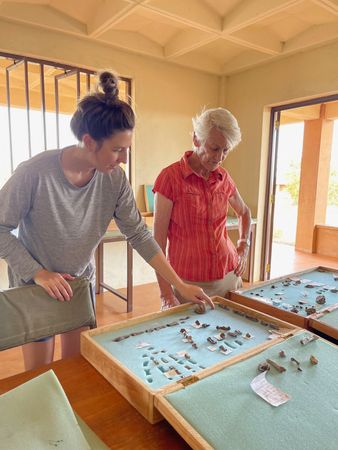By Will Dunham
(Reuters) -Researchers have unearthed near Lake Turkana in northern Kenya fossils of hand and foot bones belonging to an extinct human relative dating to 1.52 million years ago, revealing that this species would have been able to grasp and manipulate objects such as stone tools and was fully bipedal.
The fossils represented the first hand and foot bones unambiguously attributed to the species Paranthropus boisei. The researchers discovered a partial skeleton that included most of the hand, three foot bones, most of the teeth, a partial forearm bone and skull fragments.
Considering the fragmentary nature of previous fossils of this species, the new discovery was revelatory.
This species was a member of the human evolutionary lineage, essentially a cousin of Homo sapiens, which evolved much later.
Paranthropus boisei was robustly built with strong jaws and massive teeth. Its skull was adapted for heavy chewing of tough plant foods, including a crest atop the cranium to anchor large jaw muscles, while its flaring cheekbones created a dish-shaped face. Without hand and foot fossils, it had been difficult to understand the species, including whether or not it would have been capable of making and using simple tools.
"Sixty-five years after the original discovery of this species, this is the first time we can confidently link Paranthropus boisei to specific hand and foot bones," said paleoanthropologist Carrie Mongle of Stony Brook University in New York, lead author of the study published this week in the journal Nature.
The fossils were discovered in a region called Koobi Fora, located on the eastern side of Lake Turkana.
"Before this find, scientists were limited to the cranial and dental remains of this species, and very little was known about the rest of the skeleton," said paleoanthropologist and study co-author Louise Leakey, director of the Koobi Fora Research Project.
The hand bones show it could form precision grips similar to modern humans, suggesting this species would have been capable of making and using stone tools, Mongle said.
"It would have had a very firm handshake," Leakey said. "We can tell that the hand of this species was built for forceful and sustained grips, and similar to gorillas in that it would have used its hands to process tough plant foods, stripping, tearing or crushing vegetation, which is consistent with its hard and fibrous diet, as seen from its robust dentition."
The fossils also provided insight into its locomotion, showing the species was adapted to walking upright on two legs.
"We can tell from the few foot bones that it was fully bipedal, not flat-footed like a chimp, and that its foot would have had a lateral arch, similar to ours, which would have propelled it forward while it walked," Leakey said.
Species from the human evolutionary lineage are called hominins. Paranthropus boisei was one of four hominin species that shared the landscape of East Africa between approximately one and two million years ago. Stone and bone tools from that period have been discovered, though it has been unclear whether Paranthropus would have been able to make and use such things.
The term genus refers to a group of closely related species, and our species belongs to the genus Homo. The extinct species Homo habilis, Homo rudolfensis and Homo erectus were contemporaneous with Paranthropus boisei in East Africa.
Some of these species crossed paths, literally. A study published last year showed that Paranthropus boisei and Homo erectus left intersecting trackways of footprints in what had been a muddy lakeshore at Koobi Fora. The discovery raised intriguing questions about the relationship between the two species and any competition for resources.
"Conventional wisdom has been that while Homo specialized in larger brains and stone tool-making that made them highly adaptable to a changing climate, Paranthropus boisei became a dietary specialist focused on grasses," Mongle said.
Ultimately, Paranthropus went extinct, "an evolutionary dead end," Leakey said.
(Reporting by Will Dunham in Washington, Editing by Rosalba O'Brien)







